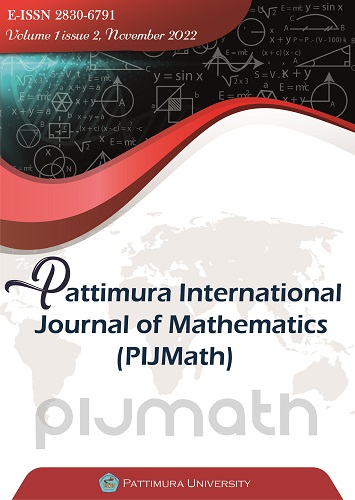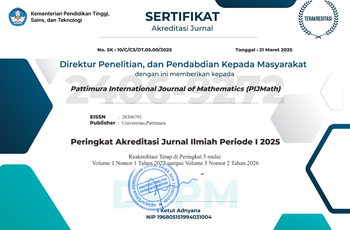Correspondence Analysis to Know Factors Related to the Use of Reducant Herbicide on Pagaralam Coffee Farmers
Abstract
Weed control is an attempt to care for agricultural land that can affect coffee production. This study aims to analyze the factors that have a relationship with the use of reductant herbicide in Pagaralam coffee farmers by using simple correspondence analysis. The research data included 19 variables and 3 categories of respondents based on the use of reductant herbicide, namely non-users, new users, and users. At the initial stage, each variable was carried out a mean difference test between 2 categories of respondents. Furthermore, each variable is divided into several categories. Then, by using the independence test, the categories of each variable are associated with the category of reductant use. There are 7 factors that have a relationship with the use of reductants, namely education of respondents, age of trees, length of harvest, frequency of herbicide use, frequency of chemical fertilizers used, frequency of organic fertilizers used, and number of labour outside the family (TL). The results of the correspondence analysis plot can show differences in the characteristics of the respondent's categories according to the use of reductant herbicide. The user category is dominantly characterized by having junior high school education, tree age more than 25 years, tend not to use organic fertilizer, and the harvest period can reach 3 months.
Downloads
References
R. Nopriyandi and Haryadi, “Analisis ekspor kopi indonesia,” J. Paradig. Ekon., vol. 12, no. 1, pp. 192–203, 2017, doi: https://doi.org/10.22437/paradigma.v12i1.3929.
D. J. P. Ditjenbun, Statistik Perkebunan Unggulan Nasional 2019-2021. Direktorat Jenderal Perkebunan Kementerian Pertanian, 2020.
Irmeilyana, Ngudiantoro, A. Desiani, and D. Rodiah, “Deskripsi Hubungan Luas Areal dan Produksi Perkebunan Kopi di Indonesia Menggunakan Analisis Bivariat dan Analisis Klaster,” Infomedia, vol. 4, no. 1, pp. 20–27, 2019.
Irmeilyana, Ngudiantoro, A. Desiani, and D. Rodiah, “Deskripsi hubungan luas areal dan produksi perkebunan kopi di provinsi sumatra selatan,” in Proseding SEMIRATA BKS PTN Indonesia Barat, 2019, pp. 74–86, [Online]. Available: http://semiratathe2ndicst.fmipa.unib.ac.id/wp-content/uploads/2019/11/Bidang-Matematika-lengkap.pdf.
Irmeilyana, Ngudiantoro, and D. Rodiah, “Deskripsi Profil dan Karakter Usaha Tani Kopi Pagar Alam Berdasarkan Descriptive Statistics dan Korelasi,” Infomedia, vol. 4, no. 2, pp. 60–68, 2019, doi: http://dx.doi.org/10.30811/jim.v4i2.1534.
Irmeilyana, Ngudiantoro, and D. Rodiah, “Application of Simple Correspondence Analysis to Analyze Factors that Influence Land Productivity of Pagar Alam Coffee Farming,” presented at Int. Conf. on Mathematics, Statistics, and Their Applications (ICMSA), 2019, Bogor, Indonesia. 2019.
Irmeilyana, Ngudiantoro, M. N. Samsuri, and B. Suprihatin, “Logistic regression model on land productivity of Pagar Alam coffee farming,” in J. Phys.: Conf. Ser. 1943, 2021, pp. 1–12, doi: doi:10.1088/1742-6596/1943/1/012135.
Ngudiantoro, Irmeilyana, and M. N. Samsuri, “Binary Logistic Regression Modeling on Net Income of Pagar Alam Coffee Farmers,” Int. J. Appl. Sci. Smart Technol., vol. 2, no. 2, pp. 47–66, 2020.
Irmeilyana, N. Ngudiantoro, and D. Rodiah, “CORRESPONDENCE ANALYSIS PADA HUBUNGAN FAKTOR-FAKTOR YANG MEMPENGARUHI PENDAPATAN PETANI KOPI PAGARALAM,” BAREKENG J. Ilmu Mat. dan Terap., vol. 15, no. 1 SE-Articles, Mar. 2021, doi: 10.30598/barekengvol15iss1pp179-192.
Irmeilyana, Ngudiantoro, and S. I. Maiyanti, “Socialization of sustainable Pagar Alam Coffee Farming using herbicide reductors,” Abdimas, vol. 7, no. 2, pp. 309–318, 2022, [Online]. Available: https://jurnal.unmer.ac.id/index.php/jpkm/article/view/6372.
I. Nzeyimana, A. E. Hartemink, and J. De Graaff, “Coffee farming and soil management in Rwanda,” Outlook Agric., no. March 2019, pp. 47–52, 2013, doi: 10.5367/oa.2013.0118.
IDH,” Sustainable Coffee Program: A business case for sustainable coffee production,” no. March, 2014, [Online]. Available: http://exchange.growasia.org/indonesia-business-case-sustainable-coffee-production.
TechnoServe, Improving the Productivity and Sustainability of Smallholder Coffee Farmers in Guatemala (A Case Study of TechnoServe’s coffee project in Sololá, Chimaltenango, and Socatepéquez 2012 – 2017). Washington, 2018.
Lizawati, E. Kartika, and Gusniwati, “PPM Kelompok Tani Kecamatan Betara : Aplikasi Teknologi Pupuk Organik Mikotriderm Dalam Penerapan Good Agricultural Practices Pada Budidaya Kopi Liberika Tungkal Jambi,” J. Karya Abdi Masy., vol. 3, no. 1, pp. 22–28, 2019.
W. Coffee Research, “Indonesia The Shade Catalog,” World Coffee Research, 2022. https://worldcoffeeresearch.org/resources/the-shade-catalog (accessed Jun. 27, 2022).
D. J. P. (Ditjenbun), “Tanaman Penaung Komoditas Kopi,” 2019. https://ditjenbun.pertanian.go.id/tanaman-penaung-komoditas-kopi-2/ (accessed Jan. 16, 2021).
K. Sarirahayu and A. Aprianingsih, “Strategy to Improving Smallholder Coffee Farmers Productivity Literature Study,” vol. 11, no. 1, pp. 1–9, 2018.
J. Kath, V. Mittahalli, Byrareddy, S. Mushtaq, A. Craparo, and P. Mario, “Temperature and rainfall impacts on robusta coffee bean characteristics,” Clim. Risk Manag., vol. 32, no. 100281, pp. 1–15, 2021, [Online]. Available: www.elsevier.com/locate/crm.
G. Schroth, L. derach Derach, D. S. B. Cuero, J. Neilson, and C. Bunn, “Winner or loser of climate change? A modeling study of current and future climatic suitability of Arabica coffee in Indonesia,” Electron. Suppl. Mater., vol. 15, pp. 1473–1482, 2015, doi: :10.1007/s10113-014-0713-x.
N. Q. A’yunin, Achdiyat, and T. R. Saridewi, “Preferensi anggota kelompok tani terhadap penerapan prinsip enam tepat (6T) dalam aplikasi pestisida,” J. Inov. Penelit., vol. 1, no. 3, pp. 253–264, doi: https://doi.org/10.47492/jip.v1i3.73.
F. Diyasti, Y. Maryani, and E. Lizarmi, “Hati-hati Penggunaan Herbisida Justru Dapat Melemahkan Tanaman Utama,” Ditjenbun, 2021. https://ditjenbun.pertanian.go.id/hati-hati-penggunaan-herbisida-justru-dapat-melemahkan-tanaman-utama/ (accessed Jan. 16, 2021).
D. J. P. (Ditjenbun), “Sistem Budidaya Kopi Organik Solusi Untuk Bebas Glifosat,” December 29, 2021. https://ditjenbun.pertanian.go.id/sistem-budidaya-kopi-organik-solusi-untuk-bebas-glifosat/ (accessed Jan. 16, 2022).
S. Agne, “The Impact of Taxation on Pesticide Use and Income in Costa Rica’s Coffee Production,” University of Gottingen, 2000.
T. Surya, “Penurunan dosis penggunaan herbisida bisa hingga 50%,” AGRINA-ONLINE.COM, 2021. http://www.agrina-online.com/detail-berita/2021/02/18/56/7314/biaya-perkebunan-hemat-hingga-40-dengan-reduktan-herbisida (accessed Mar. 07, 2021).
KRJOGJA.com, “Weed Solut-ion’ Dukung Pertanian Berkelanjutan dan Ramah Lingkungan,” 2021. https://www.krjogja.com/angkringan/gaya-hidup/teknologi/weed-solut-ion-dukung-pertanian-berkelanjutan-dan-ramah-lingkungan/ (accessed Mar. 07, 2021).
Irmeilyana, Ngudiantoro, and S. I. Maiyanti, “Hypothesis testing in the study of the characteristics of Pagaralam coffee farmers as herbicide reductant users,” presented at Sriwijaya Int. Conf. in Basic and Applied Sciences (SICBAS), 2021, Palembang, Indonesia. 2021.
Irmeilyana, Ngudiantoro, and S. I. Maiyanti, “Regression Model on Pagaralam Coffee Farmers’ Income with the Influence of The Use of Herbicide Reductant Variable,” BAREKENG J. Ilmu Mat. dan Terap., vol. 16, no. 2, pp. 409–420, 2022, doi: https://doi.org/10.30598/barekengvol16iss2pp409-420.
Ermawati and M. F. Nur, “Analisis korespondensi untuk mengetahui variabel unggulan,” J. MSA, vol. 2, no. 1, pp. 60–68, 2014.
R. A. Johnson and D. W. Wichern, Applied Multivariate Statistical Analysis, 6th ed. New Jersey: Prentice-Hall, Inc., 2007.
R. E. Walpole, Pengantar Statistika (Introduction to Statistics); Alih Bahasa: Bambang Sumantri, 3rd ed. Jakarta: PT. Gramedia, 1990.
A. Widarjono, Statistika Terapan dengan Excel dan SPSS, Kedua. Yogyakarta: UPP STIM YKPN, 2019.
A. Saefuddin, K. A. Notodiputro, A. Alamudi, and K. Sadik, Statistika Dasar. Jakarta: PT. Grasindo, 2009.
I. M. Sumertajaya and A. A. Mattjik, Sidik Peubah Ganda. Bogor: IPB Press, 2011.
Copyright (c) 2022 Irmeilyana Irmeilyana, Ngudiantoro Ngudiantoro, Sri Indra Maiyanti, Indrike Febriyanti

This work is licensed under a Creative Commons Attribution-NonCommercial 4.0 International License.
The author(s) hold the copyright of the published article without restriction. This policy means that the journal allows the author(s) to hold and retain publishing rights without restrictions.
The author(s) holds the copyright of published articles without limitation. This policy means that the journal allows the author to hold and retain publishing rights without restrictions. Journal editors are given the copyright to publish articles in according to agreement signed by the author and also include statement of originality of the article


.jpg)












 This work is licensed under a
This work is licensed under a 